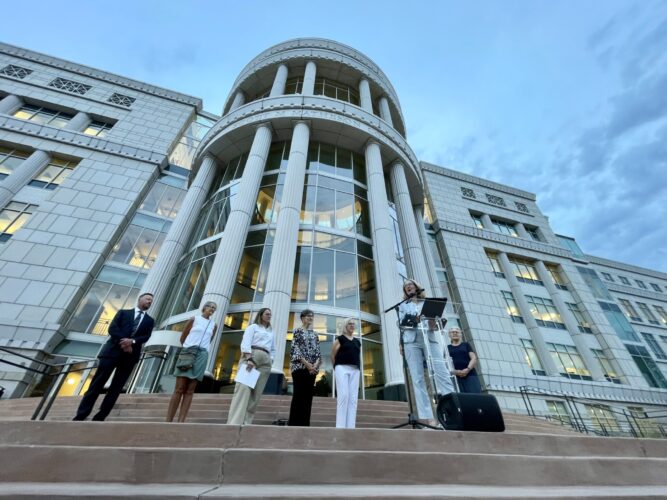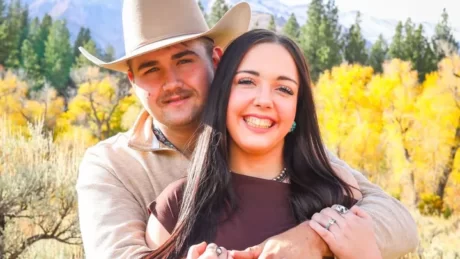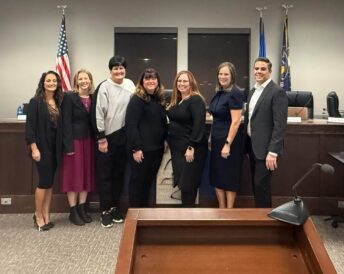Plaintiffs submit 2 congressional maps to judge as Utah lawmakers vote on their own
Utah’s court-ordered redistricting process is far from over

Katie McKellar, Utah News Dispatch
Plaintiffs in an anti-gerrymandering lawsuit hold a news conference outside the Matheson Courthouse in downtown Salt Lake City on Aug. 25, 2025.Shortly after the Utah Legislature voted Monday to pick its preferred congressional map to submit to a judge in Utah’s court-ordered redistricting process, the plaintiffs in the lawsuit that has successfully challenged the state’s last congressional map also met their deadline to submit their preferred maps to the courts.
The plaintiffs — the League of Women Voters of Utah, Mormon Women for Ethical Government, the Campaign Legal Center and several Salt Lake County voters — announced they had submitted two maps for 3rd District Judge Dianna Gibson to consider as alternatives to lawmakers’ map C, which the Utah Republican Party urged members to support in an email last week.
“These maps were submitted because the map enacted by the Legislature … fails to abide by and conform to Proposition 4’s requirements,” the announcement issued by the Campaign Legal Center said.
Proposition 4 is the 2018 voter-approved ballot initiative that has since been reinstated as law by the courts after Gibson ruled lawmakers overstepped their constitutional authority when they repealed and replaced it with a law that turned an independent redistricting commission into an advisory body that lawmakers could ignore. That ruling also voided the state’s congressional boundaries last drawn in 2021, deeming them the result of an unconstitutional process.
Plaintiffs’ proposed maps
The redistricting lawsuit’s plaintiffs have proposed two maps: Map 1 and Map 2.
Map 1, they said, “comes from a set of 10,000 maps generated by a computer algorithm designed to comply with Proposition 4’s priority-ordered redistricting criteria without considering partisan data.” It splits only one city and “has a significant population overlap” with the Orange and Purple maps proposed by the Independent Redistricting Commission in 2018.
Plaintiffs described Map 2 as a “least change” map based on the Legislature’s adopted map C but with “changes made to correct its failures to conform to Proposition 4’s requirements.”
“In particular, it corrects the enacted map’s failure to minimize municipal and county splits to the greatest extent practicable and the enacted map’s failure to comply with Proposition 4’s prohibition on party favoritism,” the plaintiffs said, adding that Map 2 only splits one city with an average of 84.1% population overlap with the Legislature’s map.
In a court filing submitted to the court Monday, plaintiffs’ attorneys said maps 1 and 2 are “contiguous, preserve communities of interest, and follow natural and geographic boundaries as required by Proposition 4.”
“Neither map purposefully nor unduly favors or disfavors any political party, as Plaintiffs will demonstrate in their forthcoming brief and expert reports,” they wrote in the court filing.
Utah’s court-ordered redistricting process is far from over.
The judge has given plaintiffs and legislative attorneys until Oct. 17 to file briefs, expert reports and other materials in support or opposition to map submissions, if necessary, to help inform her decision.
Then, on Oct. 23 and Oct. 24, the court could hold an evidentiary hearing, if needed.
Nov. 10 marks the latest possible date for the court to select a final map in time for the 2026 elections, according to the office of the lieutenant governor, who is the state’s top election official.
Meanwhile, Republican legislative leaders have vowed to continue to fight Gibson’s ruling in court — up to the U.S. Supreme Court if necessary.



